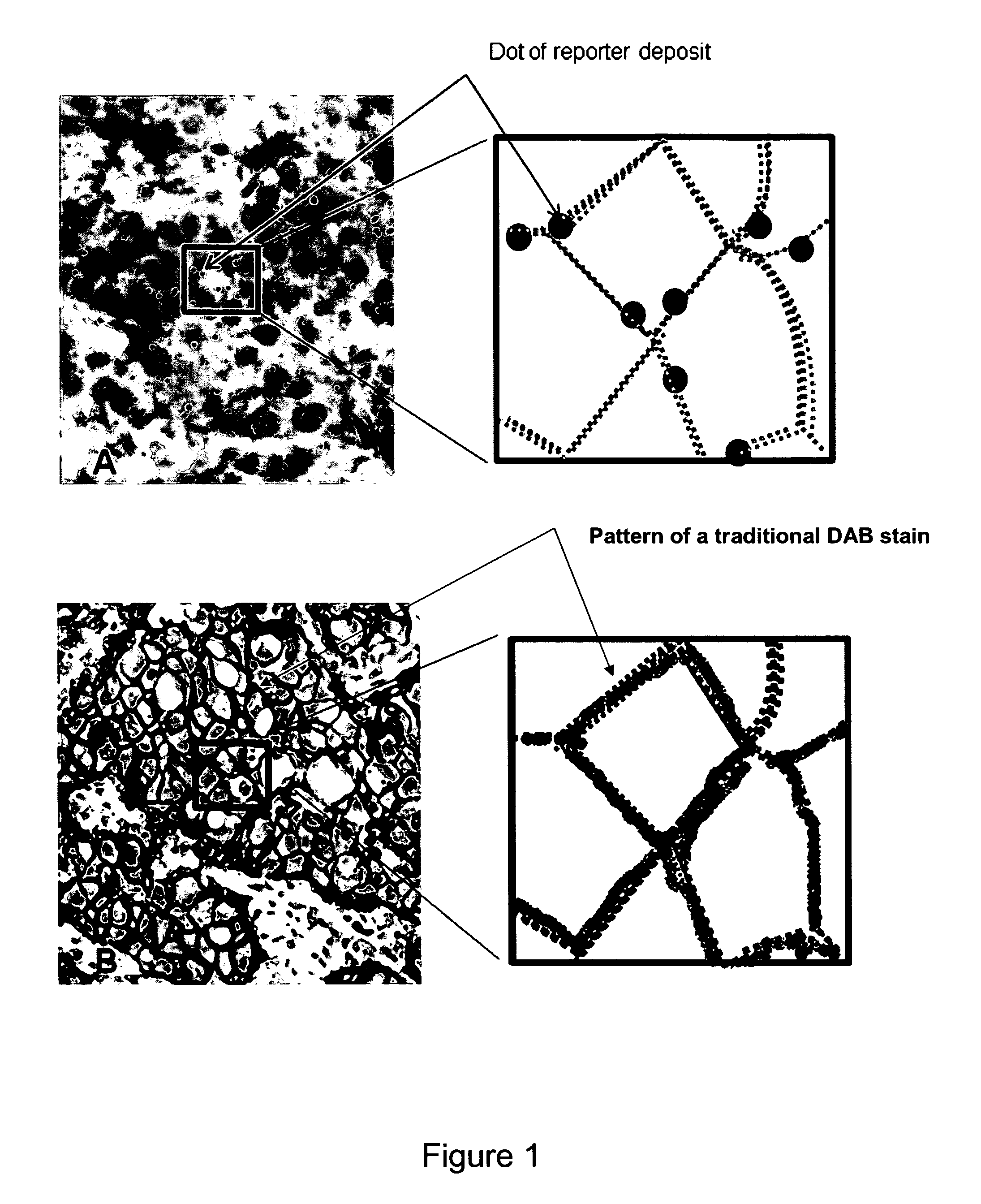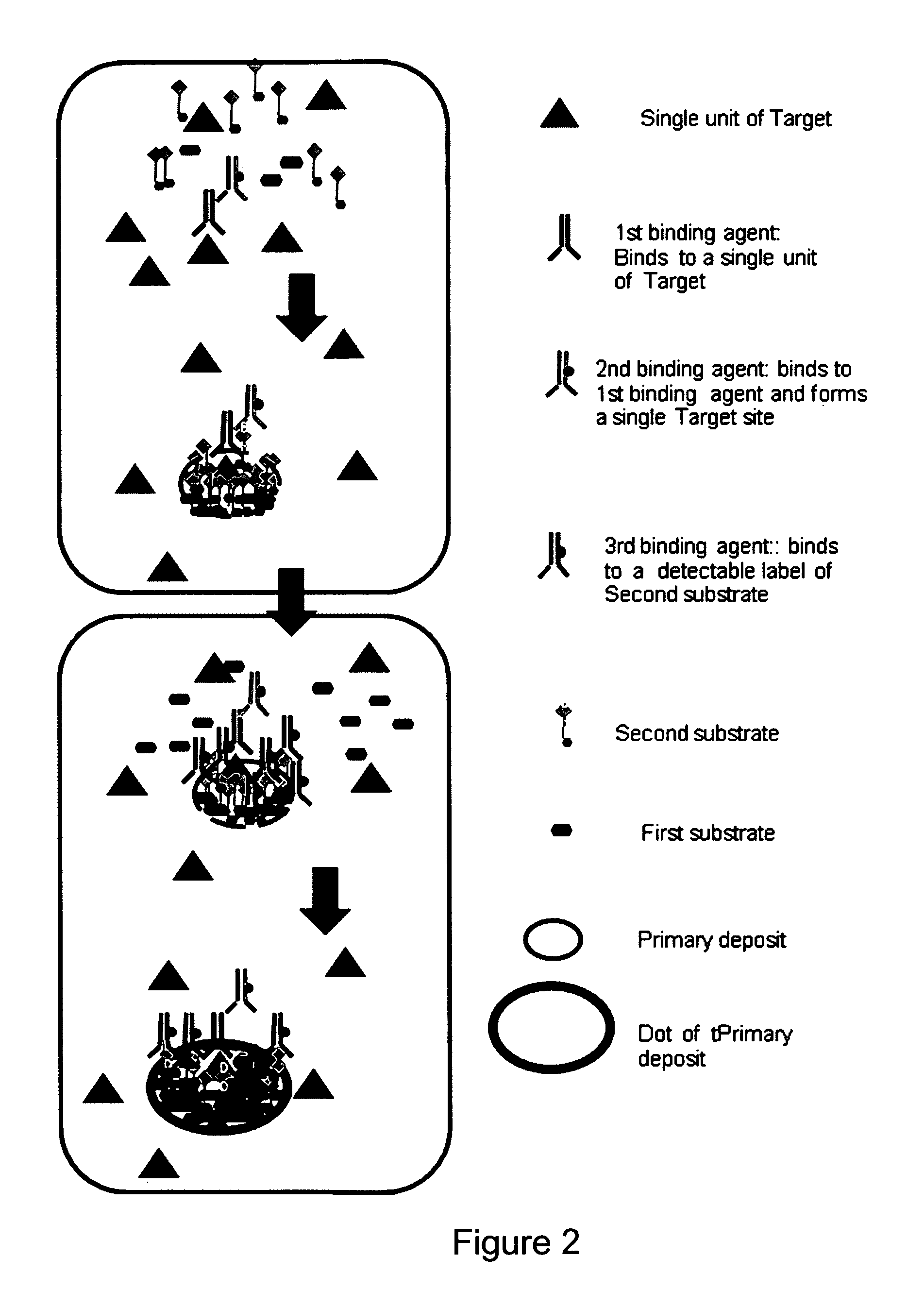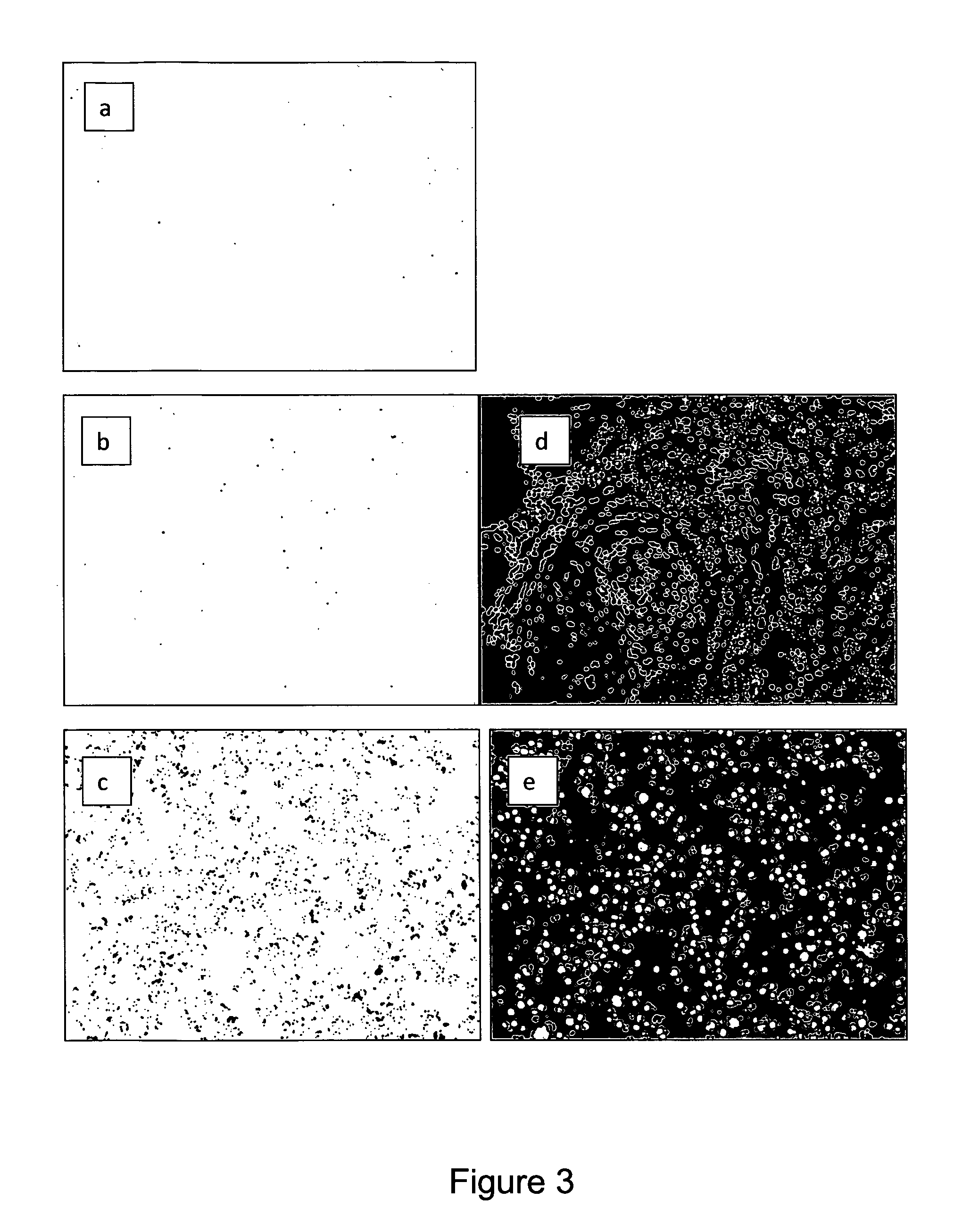Immunochemical detection of single target entities
a single target and immunochemical technology, applied in the field of immunochemical visualization and quantification of single target entities, can solve the problems of inability to detect targets present at low levels, additional difficulty in applying antibodies to cells and tissues, and inability to detect targets at low levels, so as to achieve rapid, simple and robust methods
- Summary
- Abstract
- Description
- Claims
- Application Information
AI Technical Summary
Benefits of technology
Problems solved by technology
Method used
Image
Examples
example 1
Dot Size as Function of the Amount of Reporter, DAB and H2O2 in Incubation Media or Incubation Time
General Procedure:
[0631]Staining experiments were run on formalin fixed paraffin embedded tissue. As pretreatment slides were de-paraffinized in 2 baths of xylene (5 min each), two baths of 96% ethanol, 2 baths of 70% ethanol (2 min each). The slides were then boiled in a microwave oven for 10 min in target retrieval solution (Dako S 1699). The slides were allowed to cool, endogenous peroxidase activity was quenched with 10% hydrogen peroxide for 2 min
experiment 1
[0632]All slides were: incubated with an experimental monoclonal mouse antibody directed at the C-terminal of the HER2 protein was used, “clone 6C2”, The following protocol was used: Incubation with clone 6C2, 55 picoM for 3 min, washed with wash buffer (Dako S3306) then incubation with GaM / HRP (D20052 frac. 8) in concentration 370 picoM for 3 min, then washed. Then the slides were subjected to a deposition step, a reporter binding agent step (all reporters, D19112, D20068, D20086, D20118, D20120 were used in concentration 10 μM) and a staining step with LPR chromogen as detailed in table 1. Washing steps were used between each step.
[0633]
TABLE 1Detection (step c)DepositionReporter binding agentStain media (step b)(step c′)(step c″)Slide 1D19112: DAB 0.28 mM,D20036 50 nM,LPR 10 minH2O2 1.5 mM, 10 min10 minSlide 2D19112: DAB 0.28 mM,D20036 50 nM,LPR 5 minH2O2 1.5 mM, 10 min10 minSlide 3D19112: DAB 0.28 mM,D20036 50 nM,LPR 3 minH2O2 1.5 mM, 10 min10 minSlide 4D19112: DAB 0.28 mM,D2003...
experiment 2
[0634]All slides were treated as in example 1, then subjected to deposition, reporter binding agent and chromogen stain as detailed in table 2.
[0635]
TABLE 2Detection (step c)DepositionReporter bindingStainmedia (step b)agent (step c′)(step c″)Slide 1D19112: 10 μM,D20036 50 nM, 10 minLPR 10 minDAB 0.14 mM,H2O2 1.5 mM, 10 minSlide 2D19112: 20 μM,D20036 50 nM, 10 minLPR 10 minDAB 0.14 mM,H2O2 1.5 mM, 10 minSlide 3D19112: 5 μM,D20036 50 nM, 10 minLPR 10 minDAB 0.14 mM,H2O2 1.5 mM, 10 minSlide 4D19112: 3 μM,D20036 50 nM, 10 minLPR 10 minDAB 0.14 mM,H2O2 1.5 mM, 10 minSlide 5D19112: 2 μM,D20036 50 nM, 10 minLPR 10 minDAB 0.14 mM,H2O2 1.5 mM, 10 minSlide 6D19112: 1 μM,D20036 50 nM, 10 minLPR 10 minDAB 0.14 mM,H2O2 1.5 mM, 10 minSlide 7D19112: 10 μM,D20036 100 nM, 10 minLPR 10 minDAB 0.14 mM,H2O2 1.5 mM, 10 minSlide 8D19112: 10 μM,D20036 25 nM, 10 minLPR 10 minDAB 0.14 mM,H2O2 1.5 mM, 10 minSlide 9D19112: 10 μM,D20036 12.5 nM, 10 minLPR 10 minDAB 0.14 mM,H2O2 1.5 mM, 10 minSlideD19112: 10 μ...
PUM
| Property | Measurement | Unit |
|---|---|---|
| diameter | aaaaa | aaaaa |
| pH | aaaaa | aaaaa |
| pH | aaaaa | aaaaa |
Abstract
Description
Claims
Application Information
 Login to View More
Login to View More - R&D
- Intellectual Property
- Life Sciences
- Materials
- Tech Scout
- Unparalleled Data Quality
- Higher Quality Content
- 60% Fewer Hallucinations
Browse by: Latest US Patents, China's latest patents, Technical Efficacy Thesaurus, Application Domain, Technology Topic, Popular Technical Reports.
© 2025 PatSnap. All rights reserved.Legal|Privacy policy|Modern Slavery Act Transparency Statement|Sitemap|About US| Contact US: help@patsnap.com



